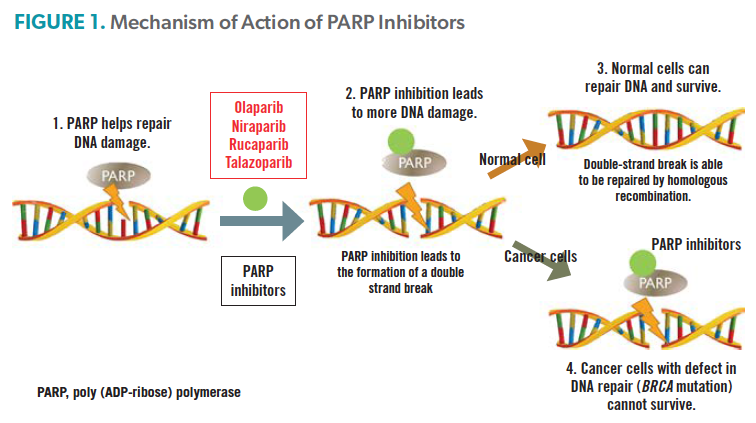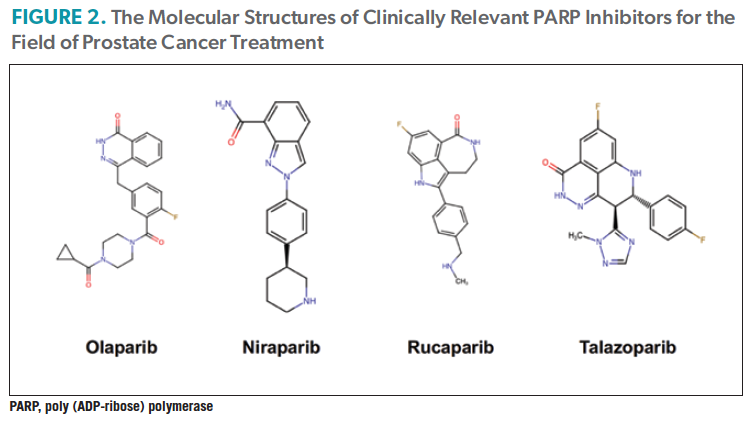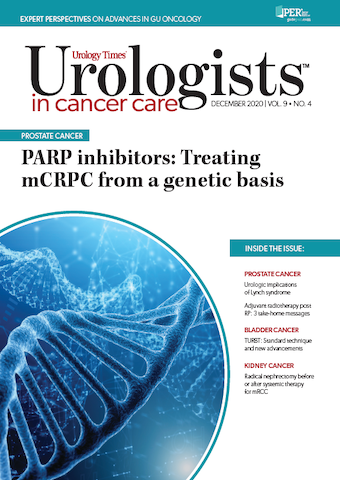Publication
Article
Urology Times Urologists in Cancer Care
PARP inhibitors: Treating mCRPC from a genetic basis
Author(s):
Treatments provide a targeted therapeutic strategy for metastatic castration-resistant prostate cancer.
In recent years, prostate cancer has grown to become the most common carcinoma affecting men in terms of incidence and the second most common in terms of mortality. The American Cancer Society estimates that in 2020, there will be 191,930 new cases and 33,330 deaths from prostate cancer.1 It was well known for many years that approximately a quarter of men who develop metastatic castration-resistant prostate cancer (mCRPC) have a mutation in DNA repair genes, with the most common mutated genes being BRCA2 (44%), ATM (13%), CHEK2 (12%), and BRCA1 (7%).2 It was previously thought that these patients harbored somatic mutations that could develop at any time in a patient’s life, with the frequency of these DNA repair aberrancies increasing with continued disease progression. However, recent discoveries in the last 5 years have indicated that up to 12% of all men with mCRPC have germline/inherited defects in DNA repair genes.3 This distinction is important because new data suggest that patients with prostate cancer with BRCA2 mutations have earlier onset of disease, lower overall survival rates, and shorter progression-free survival rates.4
The discovery of germline DNA repair gene mutations is significant in that it changes the entire paradigm of family history investigation algorithms that occur during the first clinical encounter with a patient with a new diagnosis of prostate cancer. The increased risk is specifically correlated to the BRCA1 and BRCA2 DNA repair genes, which have been well established as genes whose mutations confer an increased chance of breast and ovarian cancer development in women. Now clinical investigation on the part of physicians must include the consideration that just as having a father or brother with prostate cancer can double a man’s risk of developing prostate cancer, having a mother or sister with breast or ovarian cancer can increase this same man’s risk of developing prostate cancer. This rationale has been reflected in the most recent National Comprehensive Cancer Network (NCCN) guidelines for 2020, while only 2 years ago genetic testing was not widely promoted. Now, germline genetic testing is recommended for every patient with prostate cancer with high-risk disease, regional spread, and metastases. In addition to these disease statuses, patients with a family history of high-risk germline mutations (BRCA1/BRCA2, etc), a family history of cancer, and Ashkenazi Jewish ancestry are also candidates for genetic testing.5 Somatic tumor testing is recommended in prostate cancer with both regional and metastatic spread. Thus, it is strongly encouraged that almost every patient with prostate cancer, except for the very low-risk patients, undergo genetic testing according to the new NCCN guidelines.5

The answer to the question of how one can account for germline mutations in DNA repair genes for the treatment of mCRPC lies in the mechanism of action of poly (ADP-ribose) polymerase (PARP) inhibitors (Figure 1). When a single strand break in DNA occurs, PARP1 proteins repair the break in a mechanism called base excision repair. With a double-strand DNA break, DNA repair genes (the most recognizable being BRCA1 and BRCA2) initiate repair through a mechanism known as homologous recombination.6 When there is a knockout mutation in DNA repair genes (somatic or inherited germline), aberrant DNA with breaks that cannot be repaired begin to accumulate. This is the catalyst for carcinogenesis. PARP inhibition works through a rationale called synthetic lethality, which essentially is a mechanism of cell death that occurs when both the single-strand and double-strand DNA repair pathways are inhibited.6 In the case of a germline mutation of DNA repair genes, the double-strand DNA repair pathway (homologous recombination) is already knocked out. Therefore, the last step for synthetic lethality of cancer cells to work would be to impair the single-strand repair pathway (base excision repair) through the inhibition of PARP1. This can be achieved through PARP inhibitors and lead to a cascade of cell death in tumor cells.6
Before discussing the available PARP inhibitors that physicians can employ in targeting prostate cancer, it is important to distinguish that there are 2 main mechanisms of action by which PARP inhibitors work. One method of inhibition is through the direct blockade of the enzymatic activity of PARP1 and PARP2, and the second is through “PARP trapping” on the DNA and preventing its release.7 There are many PARP inhibitors available, but the most important for the field of prostate cancer treatment are olaparib (Lynparza), rucaparib (Rubraca), niraparib (Zejula), and talazoparib (Talzenna) (Figure 2).

The PROfound Study (NCT02987543) was a trial that studied 387 patients with mCRPC who had progressed on a hormonal agent such as enzalutamide (Xtandi) or abiraterone (Zytiga) and had 1 or more homologous gene repair mutations in a 15-gene panel that was utilized for this study. Cohort A consisted of 245 patients with BRCA1, BRCA2, or ATM gene mutations, and cohort B consisted of 142 patients with 1 or more of the other 12-gene panel aberrations.8 Patients were randomized 2:1 to receive 300 mg of olaparib orally twice daily or physician’s choice of either 160 mg of enzalutamide orally once daily or 1000 mg of abiraterone acetate orally once daily with 5 mg of prednisone twice daily.8 Median progression-free survival (PFS) in cohort A in the patients who received olaparib was 7.39 months compared with a PFS of 3.55 months in the patients who received enzalutamide or abiraterone (HR, 0.34; 95% CI, 0.25-0.47; P < .001).8 Overall survival in cohort A with the patients receiving olaparib was 18.5 months versus 15.1 months in the patients receiving the physician's choice of treatment (HR, 0.64; (95% CI, 0.43-0.97; P = .02).8 Common adverse events (AEs) of olaparib that physicians must be aware of are anemia, fatigue, nausea, anorexia, diarrhea, thrombocytopenia, creatinine elevation, cough, and dyspnea. Very rare but serious complications of olaparib are myelodysplastic syndrome development, acute myeloid leukemia development, pneumonitis, and deep vein thrombosis or pulmonary embolism.8 The groundbreaking PROfound Study led the FDA, on May 19, 2020, to approve olaparib for the treatment of patients with mCRPC who have pathogenic germline or somatic homologous DNA gene repair mutations, and who have progressed following prior treatment on enzalutamide or abiraterone.
The TRITON2 study (NCT02952534) was a phase 2 trial that examined the efficacy of rucaparib in patients with metastatic castration-resistant prostate cancer who had 1 or more somatic or germline mutations in homologous DNA repair genes and who had progressed on prior androgen receptor (AR)–directed therapy and 1 prior taxane-based chemotherapy. Patients were randomized to receive 600 mg of rucaparib twice daily in 28-day cycles every 8 weeks for 24 weeks then every 12 weeks.9 Primary end points that were measured were objective response rates (ORRs) and prostate-specific antigen (PSA) rates among each homologous DNA repair gene mutation. The most notable responses were among the 57 patients that had a BRCA1/BRCA2 mutation; 44% of these patients had an ORR, and there was a PSA response rate in 52% of these same patients. Among the patients with BRCA1/BRCA2 mutations, the median time to PSA progression was 6.5 months (95% CI, 5.7-7.5).9 The AE profile associated with rucaparib that physicians must be aware of includes anemia, fatigue, nausea, anorexia, diarrhea, constipation, thrombocytopenia, abnormal liver function tests, creatinine elevation, and rash. Extremely rare but very serious complications include myelodysplastic syndrome development, acute myeloid leukemia development, and teratogenic effects to the fetus if taken while pregnant.9 The ongoing TRITON3 study (NCT02975934) is studying efficacy of rucaparib in patients with mCRPC who had progressed on prior AR-directed therapy but are chemotherapy naïve. The TRITON2 study led to accelerated approval of rucaparib on May 15, 2020, for patients with mCRPC with BRCA1/BRCA2 knockout mutations who have been previously treated with AR-antagonist therapy or taxane-based chemotherapy.
The time has now come to think about and treat mCRPC from a genetic basis, especially in the case of patients with earlier carcinogenesis and more aggressive disease. Though the vast majority of mCRPC cases will be acquired in a patient’s lifetime, thousands of patients with inherited germline mutations will benefit from a thorough family history screening and genetic testing. Clinicians can interpret the new prostate cancer NCCN guidelines regarding genetic panel testing as essentially applying to all patients with prostate cancer, as low-risk disease is rarely present at the time of presentation in an oncology new patient visit. PARP inhibitors truly offer the solution needed to combat germline mutation-driven mCRPC. When choosing between the 2 current FDA-approved PARP inhibitors it is important for clinicians to consider that olaparib has shown efficacy against a wide range of homologous DNA repair gene mutations and rucaparib is mainly indicated to combat BRCA1/BRCA mutations at this time. There are several ongoing trials studying the efficacy of combinations of PARP inhibitors with other novel agents, and we believe the future is truly exciting in terms of the expansion of the number of patients that will benefit from treatment and the number of therapeutic options that will become available to physicians in the coming decade.
Jacob is an internal medicine resident at Baylor Scott and White Medical Center-Temple, Temple, Texas; Shook is a doctor of pharmacy student at Ohio Northern University Raabe College of Pharmacy, Ada, Ohio; Hutson is Associate Professor at Texas A&M University College of Medicine, Dallas, Texas; Webster is a urologist with Urology Clinics of North Texas, Dallas; Price is a nurse practitioner at Texas Oncology-Baylor Charles A. Sammons Cancer Center, Dallas, Texas; Puskoor is with Baylor Scott and White Medical Center-Round Rock, Round Rock, Texas; Mathew is with the University of Texas at Houston Medical Center, Houston, Texas; Khan is an internal medicine resident at Louisiana State University Health-Shreveport; and Li is with Texas Tech University Health Sciences Center School of Pharmacy, Amarillo.
References
1. American Cancer Society. Key statistics for prostate cancer: prostate cancer facts.Revised: January 8, 2020. Accessed October 16, 2020. www.cancer.org/cancer/prostate-cancer/about/key-statistics.html
2. Robinson D, Van Allen EM, Wu YM, et al. Integrative clinical genomics of advanced prostate cancer. Cell. 2015;161(5):1215-1228. doi:10.1016/j.cell.2015.05.001
3. Pritchard CC, Mateo J, Walsh MF, et al. Inherited DNA-repair gene mutations in men with metastatic prostate cancer. N Engl J Med. 2016;375(5):443-453. doi:10.1056/NEJMoa1603144
4. Castro E, Goh C, Olmos D, et al. Germline BRCA mutations are associated with higher risk of nodal involvement, distant metastasis, and poor survival outcomes in prostate cancer. J Clin Oncol. 2013;31(14):1748-1757. doi:10.1200/JCO.2012.43.1882
5. NCCN. Clinical Practice Guidelines in Oncology. Prostate cancer, version 2.2020. Accessed October 16, 2020. https://www.nccn.org/professionals/physician_gls/pdf/prostate.pdf
6. Banerjee S, Kaye SB, Ashworth A. Making the best of PARP inhibitors in ovarian cancer. Nat Rev Clin Oncol. 2010;7(9):508-519. doi:10.1038/nrclinonc.2010.116
7. Carney B, Kossatz S, Lok BH, et al. Target engagement imaging of PARP inhibitors in small-cell lung cancer. Nat Commun. 2018;9(1):176. doi:10.1038/s41467-017-02096-w
8. De Bono J, Mateo J, Fizazi K, et al. Olaparib for metastatic castration-resistant prostate cancer. N Engl J Med. 2020;382(22):2091-2102. doi:10.1056/NEJMoa1911440
9. Abida W, Bryce AH, Vogelzang NJ, et al. Preliminary results from TRITON2: a phase II study of rucaparib in patients (pts) with metastatic castration-resistant prostate cancer (mCRPC) associated with homologous recombination repair (HRR) gene alterations. Annals of Oncology. 2018;29(suppl 8):viii271-viii302. doi:https://doi.org/10.1093/annonc/mdy284.002

Newsletter
Stay current with the latest urology news and practice-changing insights — sign up now for the essential updates every urologist needs.























